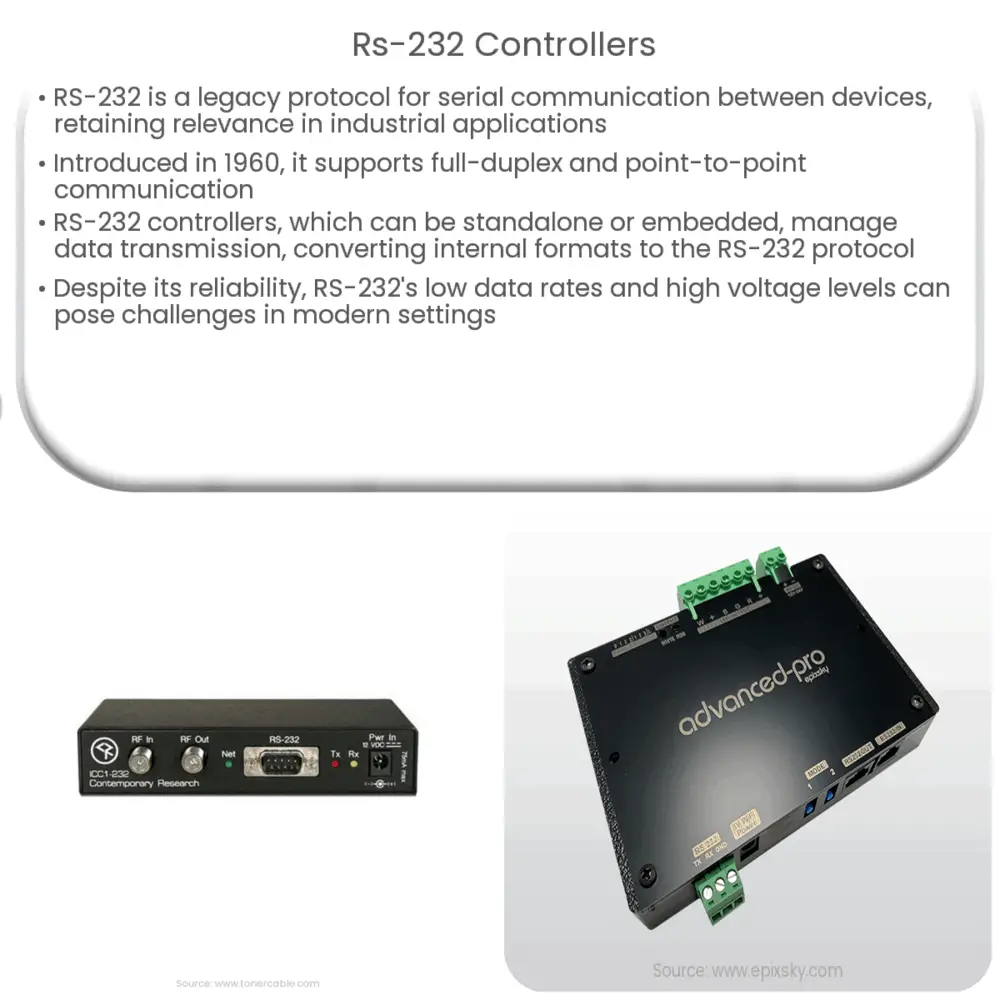Explore the fundamentals of RS-232 controllers, their role in facilitating device communication, key components, and challenges in this comprehensive article.

Understanding RS-232 Controllers
The RS-232 standard is a legacy protocol that was widely used for serial communication between devices. Despite the emergence of more modern protocols, RS-232 has retained relevance in various applications, especially in industrial settings.
RS-232: An Overview
RS-232, which stands for “Recommended Standard 232,” is a long-established standard that describes the physical interface and protocol for relatively low-speed serial data communication between computers and related devices. It was first introduced in 1960 by the Electronic Industries Association (EIA) and has been revised several times since.
RS-232 uses a full-duplex communication mode, meaning it can send and receive data simultaneously. It supports a point-to-point communication model, where one sender and one receiver are involved.
RS-232 Controllers
An RS-232 controller is a device that manages the sending and receiving of data over the RS-232 interface. These controllers are crucial for ensuring accurate, reliable communication between devices. They can be standalone units or integrated circuits embedded within larger systems.
The controller’s primary function is to convert data from the device’s internal format into the RS-232 protocol and vice versa. This process involves transforming digital signals into the RS-232’s voltage-based signaling scheme and ensuring the correct timing of bits.
Applications of RS-232 Controllers
- Industrial Equipment: RS-232 is commonly used in industrial equipment due to its simple, reliable nature. It is often found in controllers for manufacturing equipment, environmental monitoring systems, and other similar devices.
- Data Acquisition and Control: RS-232 controllers are used in data acquisition systems for reading sensors, controlling actuators, and other tasks that require interfacing with physical devices.
- Telecommunications: Although less common today, RS-232 was widely used in telecommunication systems, including modems and fax machines.
In the next section, we’ll delve into the inner workings of the RS-232 controller, its key components, how it communicates with other devices, and the challenges that come with using this legacy standard in a modern technological landscape.
Inner Workings of RS-232 Controllers
The RS-232 controller handles the translation of data between the connected device and the RS-232 interface. It does this through a process called line encoding, converting digital data into specific voltage levels suitable for transmission.
RS-232 uses a signaling method known as bipolar signaling, where a positive voltage represents one binary value, and a negative voltage represents the other. The controller ensures that the timing of these signals is consistent with the specified baud rate.
Key Components of RS-232 Controllers
- UART: The Universal Asynchronous Receiver/Transmitter (UART) is a key component of the RS-232 controller. It handles the conversion of data between parallel and serial formats.
- Line Drivers and Receivers: These components are responsible for converting the digital logic levels used by the UART to the higher voltage levels used by the RS-232 standard, and vice versa.
- Voltage Regulator: The voltage regulator ensures that the voltage levels stay within the RS-232 standard’s specified range, protecting the controller and other connected devices from potential damage.
Challenges and Considerations
While RS-232 is reliable and straightforward, it does have some limitations. Its low data rates and short maximum cable length can be problematic in certain applications. Additionally, RS-232’s use of high voltage levels compared to modern low-voltage logic can present challenges in integrating RS-232 controllers into newer systems.
Conclusion
In conclusion, the RS-232 controller plays a vital role in facilitating communication between devices via the RS-232 interface. Despite being a legacy standard, RS-232 and its controllers continue to find relevance in various industries, owing to their simple, robust nature. However, as technology continues to evolve, understanding the inner workings of these controllers and the challenges they present becomes increasingly important. Balancing the benefits of this established standard with the need for higher-speed, longer-distance communication is an ongoing consideration for engineers and system designers alike.

